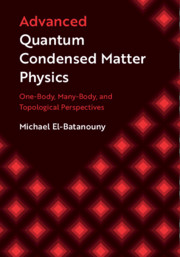Book contents
- Frontmatter
- Dedication
- Contents
- Preface
- Part One One-Electron Theory
- Part Two Topological Phases
- Part Three Many-Body Physics
- 13 Many-Body Physics and Second Quantization
- 14 The Interacting Electron Gas
- 15 Green Functions for Many-Body Systems and Feynman Diagrams
- 16 Path Integrals
- 17 Boson Systems: Bose–Einstein Condensation and Superfluidity
- 18 Landau Fermi Liquid Theory
- 19 Non-Fermi Liquids, the Luttinger Liquid, and Bosonization
- 20 Electron–Phonon Interactions
- 21 Microscopic Theory of Conventional Superconductivity
- 22 Quantum Theory of Magnetism: Exchange Coupling Mechanisms
- 23 Quantum Theory of Magnetism: Magnetic Insulator Ground States and Spin-Wave Excitations
- 24 Quantum Theory of Magnetism: Itinerant-Electron Systems and the Kondo Effect
- References
- Index
15 - Green Functions for Many-Body Systems and Feynman Diagrams
from Part Three - Many-Body Physics
Published online by Cambridge University Press: 06 March 2020
- Frontmatter
- Dedication
- Contents
- Preface
- Part One One-Electron Theory
- Part Two Topological Phases
- Part Three Many-Body Physics
- 13 Many-Body Physics and Second Quantization
- 14 The Interacting Electron Gas
- 15 Green Functions for Many-Body Systems and Feynman Diagrams
- 16 Path Integrals
- 17 Boson Systems: Bose–Einstein Condensation and Superfluidity
- 18 Landau Fermi Liquid Theory
- 19 Non-Fermi Liquids, the Luttinger Liquid, and Bosonization
- 20 Electron–Phonon Interactions
- 21 Microscopic Theory of Conventional Superconductivity
- 22 Quantum Theory of Magnetism: Exchange Coupling Mechanisms
- 23 Quantum Theory of Magnetism: Magnetic Insulator Ground States and Spin-Wave Excitations
- 24 Quantum Theory of Magnetism: Itinerant-Electron Systems and the Kondo Effect
- References
- Index
Summary
Develops the many-body one-particle Green function, and explains its physical interpretation in terms of the spectral function, self-energy, and quasiparticle. lifetime. Its application in angle-resolved photoemission spectroscopy is presented in detail. The time-evolution operator in the interaction picture is derived, and time-ordering and adiabatic switching-on are introduced as precursor tools to construct the Feynman–Dyson many-body perturbation theory. A detailed account of Wick’s theorem, normal ordering, and contractions is outlined. Feynman diagrams are constructed, and the emergence of the infinite Dyson series from irreducible diagrams is outlined. Two-particle Green function and the particle-hole excitation spectra are developed. Diagramatic application of RPA for interacting systems is described. The finite-temperature Matsubara Green function is introduced and developed, together with its Fourier series representation and the evaluation of Matsubara sums.
- Type
- Chapter
- Information
- Advanced Quantum Condensed Matter PhysicsOne-Body, Many-Body, and Topological Perspectives, pp. 425 - 517Publisher: Cambridge University PressPrint publication year: 2020

